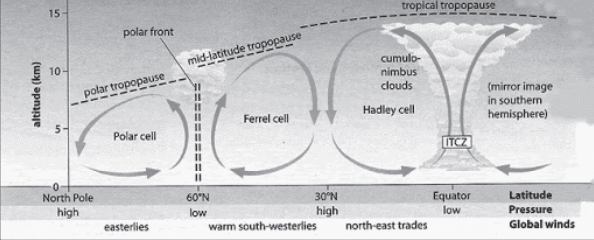-
12 Nov 2021
GS Paper 1
Geography
Q. Explain the tri-cellular atmospheric model and its importance for the world climate. (250 words)
- Define atmospheric circulation
- Discuss the tricellular atmospheric model
- Mention its importance for the world climate
Answer
Earth and its atmosphere are both controlled primarily by the Sun and they make up an interconnected global system. Different climatic areas are the result of atmospheric movements (see the tricellular model below) within this global system.
Atmospheric circulation is the large-scale movement of air and together with ocean circulation is the means by which thermal energy is redistributed on the surface of the Earth.
Tricellular Atmospheric Model
The tricellular model explains the meridional circulation of the atmosphere. According to this model, the global air circulation can be divided into three cells. These cells have been divided based on the thermal and dynamic factors associated with the global air circulation.
Hadley cell: The cell is located between 10-30 degree latitudes in both hemispheres. This is a thermally induced cell and is the result of intense solar insolation. The intense insolation produces rising air along the equator. The rising air cools down below the tropopause and diverges towards the pole as the anti-trade wind. They lead to upper air around 30 degrees latitude and sink causing the subtropical high pressure. The trade wind flows from this High Pressure toward the equator and completes this cell. It is one of the most permanent cells and is associated with a tropical monsoon and desert climate.
Ferrell Cell: This cell extends from 35 to 60-degree latitude in both hemispheres. This is a thermally indirect cell and induced due to dynamic forces. In this cell, the warm air is seen ascending from the polar front and breaking through near the tropopause. The most important feature of this cell is that the polar front is more continuous in the middle troposphere. There is a subsidence of air in the horse latitude from the tropical as well as polar front dells. On the surface, the circulation is completed by the westerly wind blowing toward the poleward side.
Polar cell: It extends from 65 to 90 degrees in both hemispheres. This is a thermally direct cell and is strongest during winter. There is sinking air along the poles which moves towards the subpolar low as the easterly wind. In the subpolar lows, the easterly and westerly interact and the air rises to complete the polar cell circulation.
ImportanceMeridional circulation plays a vital role in the transfer of energy and in maintaining the heat budget of the earth.
- It aids the formation of doldrums or the inter-tropical Convergence Zone (ITCZ)-the most important and uninterrupted belt of convergence on the surface of the earth.
- The development of tropical cyclones, temperate cyclones, and anticyclones is also the result of meridional circulation.
- The tropical deserts of the world are a manifestation of the air circulation of the Hadley cell.
- The Phenomenon of monsoon is also heavily influenced by the Upper air circulation and the trade wind movement.
- Thus, meridional circulation plays an important part in the global climate and its understanding





